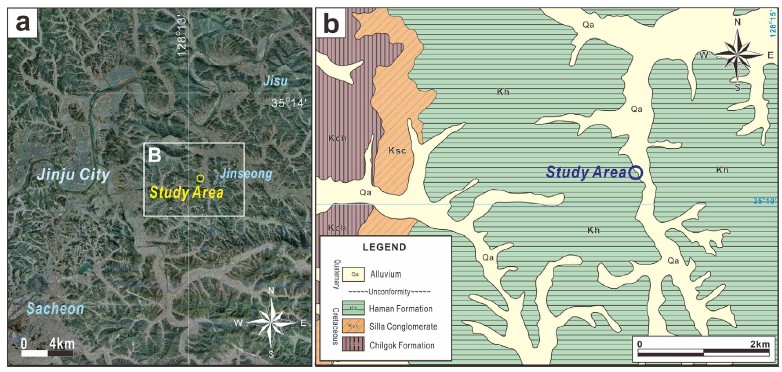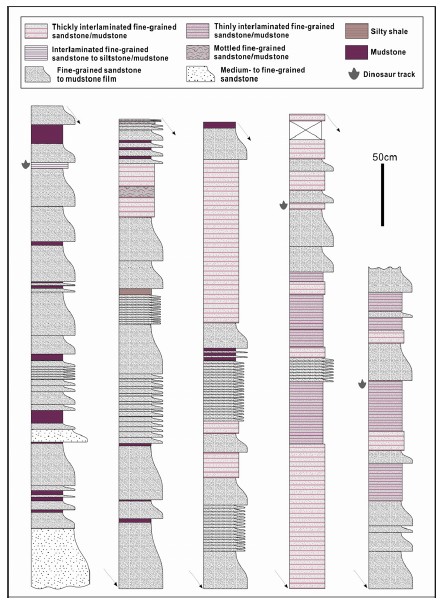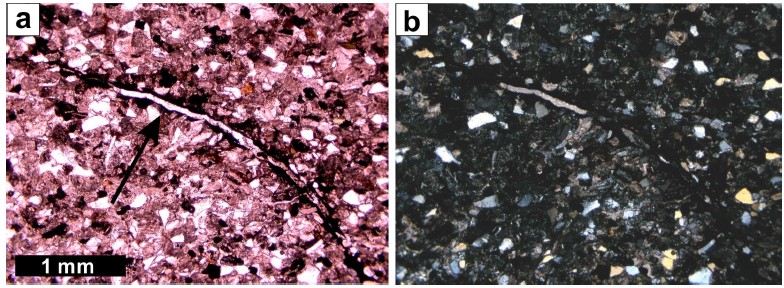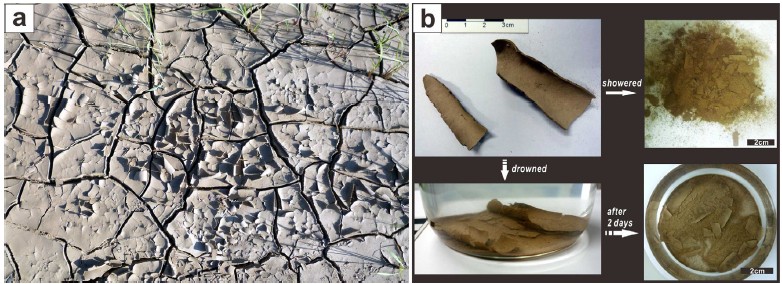
<Short Note>
Roll-up clasts in the Cretaceous Haman Formation, Korea
Roll-up structures are firstly documented from the Cretaceous Haman Formation in the vicinity of Jinju, Korea. The roll-up structure-bearing deposits consist of interbedded to interlaminated medium- to fine-grained sandstone and mudstone. The roll-up structures are preserved as intraformational clasts in medium- to fine-grained sandstone on mudstone film. The roll-up clasts are conical and their long-axes are aligned subparallel to each other. They are about 1 cm in height, up to more than 6 cm in width, and a few cm in length. The sectional shapes vary from double-rolls to single roll in margin. These roll-up clasts are interpreted to have been formed by the following sequence of events: formation of microbial mats around ponds on dry floodplain after wetting period, formation of roll-up structures by desiccation of microbial mats during subsequent drying period, erosion of roll-up structures and transportation as roll-up clasts by flooding, and deposition of roll-up clasts in sands. The preservation of microbially induced sedimentary structures (MISS) in the Haman Formation indicates that diverse types of continental MISS can be found from the Haman Formation, providing more data to understand paleoecology and paleoenvironments of the Cretaceous dry floodplains.
초록
진주 부근의 백악기 함안층 퇴적암으로부터 국내에서는 처음으로 롤업구조가 관찰되었다. 롤업구조가 산출된 퇴적층은 중립 내지 세립사암과 이암의 호층으로 이루어져 있다. 롤업구조는 이막층 위에 발달한 중립 내지 세립의 암편사암 내에 층내역의 상태로 산출한다. 이들 롤업편은 원추형을 이루며, 롤업편들의 장축방향은 서로 간에 대체로 평행하다. 롤업구조의 높이는 1 cm 내외를 가지며, 폭은 6 cm 이상까지 나타나고, 길이는 수 cm를 보인다. 롤업편들의 단면은 수 회 말린 형태로부터 끝 부분에서 1회 정도 말린 형태까지 다양하게 나타난다. 이 롤업편들은 우기가 끝난 후 건조한 평원 위에 형성된 웅덩이 주변에 시아노박테리아 등의 미생물에 의한 박층의 퇴적층이 형성된 후, 이어진 오랜 가뭄에 의해 미생물에 의한 박층이 건조되면서 롤업구조가 형성되고, 범람에 의해 롤업구조가 뜯겨져 운송되어 롤업편의 상태로 사질층에 보존된 것으로 해석된다. 함안층에 이와 같은 미생물 기원 퇴적구조(MISS)가 보존되어 있음은 함안층으로부터 다양한 유형의 육성기원 MISS가 확인될 수 있으며, 이로부터 백악기의 건조한 평원지대의 고생태와 고환경을 이해할 수 있는 더 많은 자료가 얻어질 수 있음을 시사한다.
Keywords:
Jinju, Haman Formation, Roll-up structure, Microbially induced sedimentary structure, 진주, 함안층, 롤업구조, 미생물 기원 퇴적구조1. 서 언
Schieber (1999)와 Noffke et al. (2001)에 의해 MISS(microbially induced sedimentary structures)의 발달특성과 지구생물학적 의미가 새로이 제시되면서, 세계 여러 지역의 지층으로부터 다양한 종류와 특성의 MISS가 보고되어 왔다(Gerdes, 2007; Noffke, 2010; Callow et al., 2011; Noffke et al., 2013). MISS는 퇴적물의 침식과 퇴적 및 변형과정에 시아노박테리아 등의 미생물이 영향을 미쳐 형성된 퇴적구조를 총칭하는 것으로(Noffke et al., 1995; Gerdes et al., 2000), 스트로마톨라이트가 대부분 탄산염퇴적암에 발달된 것과는 달리 쇄설성퇴적암에도 흔히 나타나는 특성을 가진다. 따라서 MISS는 스트로마톨라이트를 제외하고는 화석의 산출이 극히 드문 시생 및 원생이언의 고생태 및 고환경을 이해하는 데에 매우 유용한 퇴적기록으로 이용되고 있다(Hagadorn and Bottjer, 1997; Bouougri and Porada, 2002; Parizot et al., 2005; Schieber et al., 2007; Eriksson et al., 2012; Noffke et al., 2013).
지금까지 보고된 MISS는 주름구조(wrinkle mark), 콜리플라워구조(cauliflower structure), 망상구조(reticulate structure), 원반구조(discoidal structure), 롤업구조(roll-up structure)(Hagadorn and Bottjer, 1997; Parizot et al., 2005; Callow et al., 2011; Eriksson et al., 2012; Marriott et al., 2013) 등 다양한 종류와 특성을 가지는데, 이들의 대부분은 주로 선캠브리아이언의 지층에서 보고되었다.
이 연구의 대상이 된 롤업(roll-up)구조는 건열기원의 퇴적구조로서, 박층의 이질퇴적층이 수축에 의해 나선형 내지 원통 모양으로 말린 구조를 말한다(Demicco, 1985; Beraldi-Campesi and Garcia-Pichel, 2011). 롤업구조는 현생 조간대 환경에서 흔히 나타나며(Black, 1933; Hardie and Garrett, 1977), 범람원이나 건천 등의 육성환경에서도 나타난다(Picard and High, 1973; Allen, 1982). 지질시대 지층의 경우 롤업 구조의 대부분이 선캠브리아누대층에서 보고되었으며(Simonson and Carney, 1999; Eriksson et al., 2000; Noffke et al., 2006), 특히 천해기원의 탄산염퇴적암으로부터 보고되었다(Simonson, 1988; Simonson et al., 1993). Beraldi-Campesi and Garcia- Pichel (2011)은 이 구조의 발달에 시아노박테리아가 관여했음을 밝혔으며, 이로부터 지질시대에 보존된 롤업 구조가 시아노박테리아막(cyanobacteria-film)의 기원임을 제시하였다.
이 연구에서는 국내에서는 처음으로 백악기 경상누층군 함안층의 퇴적암으로부터 롤업구조가 기술되었다. 국내에 분포된 여러 지질시대의 퇴적암에 건열구조는 흔히 발달하며, 함안층 퇴적암의 경우 건열이 빈번히 반복되어 나타난다. 그럼에도 불구하고 이들 퇴적암에 롤업구조의 발달이 매우 드문 것은, 이 구조의 발달과 보존이 특별한 고환경적 의미를 가짐을 말해 주는 것이다. 이 연구에 의해 경남 진주시 진성면 상촌리 부근(그림 1)의 함안층 퇴적암 전석에서 다수의 롤업구조가 관찰되었으며, 이 논문에서는 이들 함안층 롤업구조의 퇴적학적 산상을 기술하고, 이로부터 이 구조의 성인과 고환경적 의미를 해석하였다.
2. 연구지역
연구지역은 진주시 진성 부근 2번 국도의 확장 공사 시 노출되었던 절취사면 지역으로, 이 지역의 퇴적암층은 경상누층군 하양층군의 함안층에 해당하는 지층이며 함안층 중하부 정도에 해당한다(그림 1). 함안층은 앨비안에서 세노마니안의 지질시대를 가지며(Kang and Paik, 2013), 붉은색의 이암과 사암의 반복된 교호가 특징인 지층으로(Um et al., 1983), 연구지역 역시 유사한 양상의 암석구성을 보인다(그림 2).
롤업구조를 함유한 전석이 산출된 퇴적층은 노출 단면의 두께가 40여 m에 이르며, 크게 중립 내지 세립사암, 이막(泥膜)을 갖는 세립사암, 세립사암 내지 실트스톤과 이암의 호엽층, 생란작용을 받은 세립사암, 세립사암과 이암의 두꺼운 호엽층, 세립사암과 이암의 얇은 호엽층, 이암 및 셰일 등으로 구성되어 있다(그림 2). 이들 퇴적층들의 색깔은 대체적으로 붉은색이 우세한 가운데에 녹색 내지 녹회색이 교호되는 양상을 띤다. 전반적으로 노출된 퇴적층의 하부는 수 십 cm 두께의 세립사암이 지배적이며, 상부는 세립사암과 이암의 호엽층이 우세한 경향을 보인다.
사암층은 일반적으로 뚜렷한 침식기저면을 가지며 정점이를 보인다. 사암층에서는 평행엽층리, 사엽층리 및 연흔엽층리가 흔히 관찰되며, 일부 세립사암층에는 생교란작용으로부터 기인된 것으로 해석되는 얼룩구조(mottled structure)가 나타난다. 사암층 위를 점이적으로 덮는 이막 및 이암의 표면에는 연흔과 건열구조가 흔히 발달되어 있으며, 여러 유형의 흔적화석, 침식에 의한 다양한 형태의 표면구조, 우흔 등이 보존되어 있다. 이들 이암층 내에서 하산동층이나 칠곡층의 이암 내에 흔히 발달되어 있는 고토양 기원의 석회질 단괴(캘크리트)는 관찰되지 않는다. 한편 연구지역 퇴적암층에서는 조각류와 수각류 공룡의 발자국과 새발자국 화석이 간헐적으로 나타난다.
3. 산 상
이 연구에서 관찰된 롤업구조는 붉은색 이막층의 표면에 발달하였던 롤업구조가 발달 이후에 발생한 범람에 의해 재동되어 이막층 위에 퇴적된 사암층 내에 퇴적물의 상태(roll-up clast: 이후 롤업편으로 기술)로 보존된 것이다(그림 3). 롤업편이 보존된 퇴적암은 이막층 위에 발달한 두께 5 cm 내외의 보통의 분급을 가지는 중립 내지 세립의 잡색 암편사암이며, 상위에는 이암편을 함유한 중립 내지 세립의 녹색 사암이 침식경계를 가지며 나타난다(그림 3a, 3c, 3e). 롤업편을 함유한 사암층에는 평행엽층리 내지 저각의 사엽층리가 발달하며(그림 3), 직경 1 cm 내외의 세립사암으로 충진된 서관구조가 산재하여 나타나고, 이 서관구조들은 롤업편을 부분적으로 관통한다(그림 3c).
롤업편들은 하위 이막층과의 경계로부터 수 mm 상위의 층준에 집중되어 산출하며, 롤업편들 사이의 간격은 2.5 cm 내지 7 cm 내외로 나타난다(그림 3). 이들 롤업편의 삼차원적 형태를 파악하기 위해 연속된 퇴적단면을 만들어 관찰한 결과, 롤업편들의 형태는 원추형으로 확인되었다. 이와 함께 이들 원추형 롤업편들의 장축 방향은 서로 간에 대체로 평행하게 배열되어 있다. 롤업편들의 퇴적단면에서의 형태는 원형에 가까운 형태에서부터 타원형까지 다양하게 나타나나, 대체적으로 압축에 의한 변형은 크지 않으며, 일부는 부러진 상태로 나타난다. 롤업구조의 내부에서는 수 회 말린 형태로부터 끝 부분에서 1회 정도 말린 형태까지 다양하게 나타난다(그림 3). 양 끝에서의 말린 형태는 대칭에서 비대칭까지 다양하게 나타난다. 롤업구조의 높이는 1 cm 내외이며, 폭은 6 cm 이상까지 나타나고, 길이는 수 cm이다. 롤업구조가 완전히 폐쇄된 경우는 관찰되지 않으며, 롤업 구조의 내부는 모두 사암으로 채워져 있다.
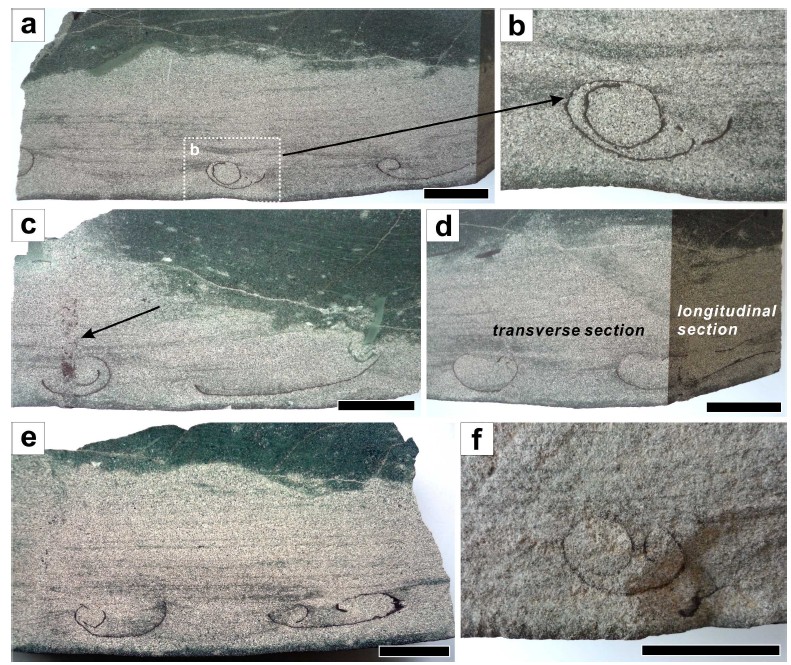
Sectional features of the roll-up clasts observed in this study. Scale bars are 2 cm in length. a. Subparallell-aligned roll-up clasts in planar- to cross-laminated medium- to fine-grained sandstone on mudstone film. b. Close-up view of a roll-up clast in a. c. Invertebrate burrow (arrow) transecting a roll-up clast. d. Roll-up clast in transverse section and longitudinal section. e, f. Single roll in both sides (right in e and f) and only in one side.
롤업편의 암상은 붉은색의 이암으로 두께는 0.05 mm로부터 1.5 mm 내외까지 나타나며, 대체적으로 중심부에서 끝 부분으로 가면서 얇아지는 경향을 보인다. 일부 롤업편의 경우, 외곽부는 이막으로 이루어진 반면 내부는 시멘트 기원의 방해석으로 채워진 양상이 관찰된다(그림 4). 이 경우 이막의 외곽부는 주변 모래의 다짐작용에 의해 불규칙한 접촉경계를 보이는 반면, 내부 방해석과의 경계는 평탄경계를 보인다(그림 4). 이와 같은 접촉특성은 퇴적초기에 롤업편을 이루는 이막 내부에 빈 공극이 형성되고, 이 내부 공극이 방해석에 의해 초기에 채워졌음을 지시한다.
4. 성 인
사질 퇴적물과 이질 퇴적물의 교호층에 건열이 발달할 경우, 표면에 덮여 있는 이질층은 점성이 낮은 하위 사질층과의 수축율 차이에 의해 경계면을 따라 분리되면서 건열의 가장자리 부근에서 말리는 현상이 일어나며, 때로 롤업의 형태로 나타난다(Picard and High, 1973; Allen, 1986; Style et al., 2011). Beraldi-Campesi and Garcia-Pichel (2011)은 현생 퇴적물에 발달된 롤업구조를 이루는 퇴적물에 대한 분석을 통해 점토질 퇴적물보다는 유기물이 함유된 퇴적물에서 롤업구조가 잘 발달하며, 점토질 퇴적물의 경우 팽창성 점토광물로 이루어진 퇴적물에서 롤업구조의 발달 가능성이 높음을 확인하였다. 이와 함께 퇴적물 내에 한천(즉 유기물)이 많을수록 롤업구조가 더욱 잘 발달하고 보존력과 침식에 대한 저항력이 높음을 실험을 통해 확인하였다(Beraldi-Campesi and Garcia-Pichel, 2011). 즉 점토질 퇴적물로 이루어진 롤업구조의 경우, 유수에 의한 운반 시 쉽게 변형되고 분절되거나 롤업이 풀어져 버리는 것에 비해, 유기질 퇴적물로 이루어진 롤업구조는 말린 형태가 잘 보존됨이 확인되었다(Beraldi-Campesi and Garcia- Pichel, 2011). 이 연구에서도 현생의 점토질 퇴적물로 이루어진 롤업구조를 물에 포화시킨 결과 롤업이 바로 풀어져버리는 현상이 확인되었다(그림 5).
이 연구에서 관찰된 롤업편들이 평행엽층리 내지 저각의 사엽층리가 발달한 사암 내에 산출하며 롤업편들의 장축 방향이 서로 간에 대체로 평행하게 배열되어 있음은 이들이 유수에 의해 운반되어 퇴적되었음을 지시한다. 따라서 Beraldi-Campesi and Garcia-Pichel (2011)과 이 연구에서의 실험 결과를 적용하였을 때, 이 연구에서 관찰된 함안층 내에 보존된 롤업구조는 유기질 퇴적물로부터 기원된 롤업구조인 것으로 해석된다. 한편 이 연구에서 관찰된 방해석으로 충진된 롤업편 내부의 미세 공극구조(그림 4)는 롤업편 내부의 유기물질이 퇴적 이후에 산화되거나 부패되어 없어지면서 남게 된 결과물인 것으로 해석된다.
5. 고환경적 의미
연구지역 퇴적층의 특징은 렌즈상으로 발달한 하도기원의 조립질 퇴적층이 수반되어 있지 않음과 사암에서 이암으로의 정점이를 보이는 수 cm 내지 수 십 cm 두께의 판상 퇴적층의 반복으로 요약될 수 있다. 이러한 퇴적 특징은 이 퇴적층이 충적평원상에서 일정한 하도를 갖지 않은 채 우기 시에만 얕은 깊이를 가지며 평원을 흐르는 유수(unconfined flow)에 의해 퇴적되었음을 지시하며(Collinson, 1996; North and Davidson, 2012), 이암층의 표면에 건열이 흔히 발달되어 있음은 우기와 건기가 반복되었음을 지시한다. 한편 함안층 내에 식생의 발달이 매우 제한적이며(Um et al., 1983) 함안층에서 산출되는 증발암광물의 캐스트는(Kim et al., 2011) 함안층 퇴적 당시의 아건조 기후조건을 시사해 준다.
일반적으로 산화작용과 탈수작용 등의 요인에 의해 지질시대의 육성환경 퇴적암에 시아노박테리아 등의 유기물이 보존되기는 어려운 것으로 알려져 있다(Bartley, 1996; Turner et al., 2000; Cady et al., 2003). 선캠브리아누대의 육성층으로부터 유기질 퇴적물 기원의 롤업구조의 발달이 일부 보고되었으나(Eriksson et al., 2000; Sarkar et al., 2006), 현생이언의 육성 기원 쇄설성 퇴적암에서의 롤업구조의 산출은 매우 드물게 보고되어 있다(Hagadorn and Mcdowell, 2012).
남한에 발달한 지질시대 육성퇴적층의 경우 롤업구조가 형성될 수 있는 건열구조를 수반한 이질층이 흔히 발달되어 있음에도 불구하고, 롤업구조는 이 연구에서 처음으로 관찰되었을 만큼 매우 드문 산출을 보인다. 이와 같은 산출 특성은 전술한 바와 같이 육성환경에서 유기질 퇴적물의 보존이 어려운 데에 기인한 것으로 여겨진다. 따라서 이 연구에서 확인된 롤업구조는 함안층의 퇴적 기간을 통해 시아노박테리아 등의 유기물에 의해 형성된 퇴적구조가 보존될 수 있는 환경이 존재하였음을 지시한다. 현생이언에 들어와 시아노박테리아를 먹이로 하는 다세포생물이 급격히 진화하면서 MISS의 보존은 상대적으로 약화되었으며(Catuneanu, 2007), 이에 따라 현생이언의 퇴적층에 보존된 MISS는 생태적으로 매우 열악한 조건(낮은 산소량과 고염도 등)을 가지는 환경의 기원을 보인다(Schieber et al., 2007; Mata and Bottjer, 2009). 이는 생태적으로 극심한 스트레스를 받는 환경이 현생이언에서 롤업구조가 보존되기에 적합한 조건임을 시사한다.
전술한 바와 같이 롤업구조가 산출한 연구지역의 함안층 퇴적층은 아건조기후 조건의 퇴적산물로 해석되며, 우기 시에 얕은 깊이의 작은 웅덩이들이 평원 곳곳에 발달한 환경에서 형성된 것으로 해석된다(Kim et al., 2011). 따라서 이 연구에서 관찰된 롤업편은 다음과 같은 과정, 즉 우기가 끝난 후에 웅덩이 주변에는 시아노박테리아 등의 미생물에 의한 박층의 퇴적층(mat)이 형성되었으며, 이어진 오랜 가뭄에 의해 웅덩이가 마르면서 미생물에 의한 박층이 건조되면서 롤업구조가 형성되고, 이후의 범람 시에 롤업구조가 뜯겨져 운송되어 롤업편의 상태로 사질퇴적층에 보존된 것으로 해석된다.
함안층의 퇴적과정 동안 이와 같은 퇴적현상은 때때로 일어났을 것으로 여겨지며, 실제로 함안층 퇴적암에는 MISS 기원으로 추정되는 퇴적구조들이 드물지 않게 관찰된다. 따라서 함안층으로부터 다양한 유형의 육성기원 MISS가 추가적으로 확인될 수 있으며, 이로부터 백악기의 건조한 평원지대에서의 고생태와 고환경이 보다 구체적으로 이해될 수 있을 것이다.
Acknowledgments
이 논문은 부경대학교 자율창의학술연구비(2013년)에 의하여 연구되었으며, 이에 감사드린다. 이 논문의 내용과 논리의 개선을 위해 유익한 지적과 도움말을 주신 경상대학교 손영관 교수님, 한국지질자원연구원 김정찬 박사님, 익명의 심사위원님, 그리고 편집위원이신 전북대학교 양우헌 교수님께 감사를 드린다.
References
- J.R.L Allen, Sedimentary Structures: Their Character and Physical Basis, Developments in Sedimentology 30B, Vol. 2, Elsevier, Amsterdam, (1982), p678.
-
J.R.L Allen, On the curl of desiccation polygons, Sedimentary Geology, (1986), 46, p23-31.
[https://doi.org/10.1016/0037-0738(86)90003-5]

-
J.K Bartley, Actualistic taphonomy of cyanobacteria: Implications for the Precambrian fossil record, Palaios, (1996), 11, p571-586.
[https://doi.org/10.2307/3515192]

-
H Beraldi-Campesi, F Carcia-Pichel, The biogenicity of modern terrestrial roll-up structures and its significance for ancient life on land, Geobiology, (2011), 9, p10-23.
[https://doi.org/10.1111/j.1472-4669.2010.00258.x]

-
M Black, The algal sediments of Andros Island, Bahamas, Philosophical Transactions of the Royal Society of London, Series B: Biological Sciences, (1933), 222, p165-192.
[https://doi.org/10.1098/rstb.1932.0015]

-
E Bouougri, H Porada, Mat-related sedimentary structures in Neoproterozoic peritidal passive margin deposits of the West African Craton (Anti-Atlas, Morocco), Sedimentary Geology, (2002), 153(85), -106.
[https://doi.org/10.1016/S0037-0738(02)00103-3]

-
S.L Cady, J.D Farmer, J.P Grotzinger, J.W Schopf, A Steele, Morphological biosignatures and the search for life on Mars, Astrobiology, (2003), 3, p351-368.
[https://doi.org/10.1089/153110703769016442]

-
R.H.T Callow, L Battison, M.D Brasier, Diverse microbially induced sedimentary structures from 1Ga lakes of the Diabaig Formation, Torridon Group, northwest Scotland, Sedimentary Geology, (2011), 239, p117-128.
[https://doi.org/10.1016/j.sedgeo.2011.06.002]

- O Catuneanu, Sequence stratigraphic context of microbial mats features, In: Atlas of Microbial mat features preserved within the clastic rock record (eds. Bose, J., Eriksson, P.K., Banerjee, P.G., Sarkar, S., Altermann, W.S., Catuneau, O.), Elsevier, Amsterdam, (2007), p276-283.
- Y.K Choi, B.H You, Explanatory text of the geologic map of Sacheon sheet (1:50,000), Geological Survey of Korea, (1969), p11.
- J.D Collinson, Alluvial sediments, In: Sedimentary Environments: Processes, Facies and Stratigraphy (ed. Reading, H.G.), Blackwell Sciences, (1996), p37-82.
- F.B Demicco, Platform and off-platform carbonates of the Upper Cambrian of western Maryland, USA, Sedimentology, (1985), 32, p1-22.
- P.G Eriksson, R Bartman, O Catuneanu, R Mazumder, N Lenhardt, A case study of microbial mat-related features in coastal epeiric sandstones from the Paleoproterozoic Pretoria Group (Transvaal Supergroup, Kaapvaal craton, South Africa); The effect of preservation (reflecting sequence stratigraphic models) on the relationship between mat features and inferred palaeoenvironment, Sedimentary Geology, (2012), p263-264, 67-75.
-
P.G Eriksson, E.L Simpson, K.A Eriksson, A.J Bumby, G.L Steyn, S Sarkar, Muddy roll-up structures in siliciclastic interdune beds of the c. 1.8 Ga Waterberg Group, South Africa, Palaios, (2000), 15, p177-183.
[https://doi.org/10.1669/0883-1351(2000)015<0177:MRUSIS>2.0.CO;2]

- G Gerdes, Structures left by modern microbial mats in their host sediments, In: Atlas of Microbial mat features preserved within the clastic rock record (eds. Bose, J., Eriksson, P.K., Banerjee, P.G., Sarkar, S., Altermann, W.S., Catuneau, O.), Elsevier, Amsterdam, (2007), p5-38.
-
G Gerdes, T Klenke, N Noffke, Microbial signatures in peritidal siliciclastic sediments: a catalogue, Sedimentology, (2000), 47, p279-308.
[https://doi.org/10.1046/j.1365-3091.2000.00284.x]

-
J.W Hagadorn, D.J Bottjer, Wrinkle structures: Microbially mediated sedimentary structures common in subtidal siliciclastic settings at the Proterozoic-Phanerozoic transition, Geology, (1997), 25, p1047-1050.
[https://doi.org/10.1130/0091-7613(1997)025<1047:WSMMSS>2.3.CO;2]

-
J.W Hagadorn, C Mcdowell, Microbial influence on erosion, grain transport and bedform genesis in sandy substrates under unidirectional flow, Sedimentology, (2012), 59, p795-808.
[https://doi.org/10.1111/j.1365-3091.2011.01278.x]

- L Hardie, P Garrett, General environmental setting. In: Sedimentation of the Modern Carbonate Tidal flats of Northwest Andros Island, Bahamas (ed. Hardie, L), The John Hopkins University Press, Baltimore, MD, (1977), p12-49.
- H.C Kang, I.S Paik, Review on the geological ages of the formations in the Gyeongsang Basin, Korea, Journal of the Geological Society of Korea, (2013), 49, p17-29.
- H.J Kim, I.S Paik, M Huh, Bird footprint-bearing deposits from the Cretaceous Haman Formation in the southern Gyeongsang Basin: occurrences, taphonomy and paleoenvironments, Journal of the Geological Society of Korea, (2011), 47, p97-122.
- O.J Kim, S Yoon, Explanatory text of the Geologic map of Jinju sheet (1:50,000), Geological Survey of Korea, (1969), p11.
-
S.B Marriott, R.D Hillier, L.B Morrissey, Enigmatic sedimentary structures in the Lower Old Red Sandstone, south Wales, UK: possible microbial influence on surface processes and early terrestrial food webs, Geological Magazine, (2013), 150, p396-411.
[https://doi.org/10.1017/S0016756812000507]

-
S.A Mata, D.J Bottjer, The paleoenvironmental distribution of Phanerozoic wrinkle structures, Earth-Science Reviews, (2009), 96, p181-195.
[https://doi.org/10.1016/j.earscirev.2009.06.001]

- N Noffke, Geobiology: Microbial Mats in Sandy Deposits from the Archean Era to Today, Springer, Berlin, (2010), p194.
- N Noffke, N Beukes, J Gutzmer, R Hazen, Spatial and temporal distribution of microbially induced sedimentary structures: a case study from siliciclastic storm deposits of the 2.9 Ga Witwatersrand Supergroup, South Africa, Precambrian Research, (2006), 146, p35-44.
- N Noffke, D Christian, D Wacey, R.M Hazen, Microbially Induced Sedimentary Structures Recording an Ancient Ecosystem in the ca. 3.48 Billion-Year-Old Dresser Formation, Pilbara, Western Australia, Astrobiology, (2013), 13, p1103-1124.
- N Noffke, G Gerdes, T Klenke, W.E Krumbein, Microbially induced sedimentary structures, Tagung Sediment 95, Freiberg, Abstracts, (1995), p141.
-
N Noffke, G Gerdes, T Klenke, W.E Krumbein, Microbially induced sedimentary structures-a new category within the classification of primary sedimentary structures, Journal of Sedimentary Research, (2001), 71, p649-656.
[https://doi.org/10.1306/2DC4095D-0E47-11D7-8643000102C1865D]

-
C.P North, S.K Davidson, Unconfined alluvial flow processes: Recognition and interpretation of their deposits, and the significance for palaeogeographic reconstruction, Earth-Science Reviews, (2012), 111, p199-223.
[https://doi.org/10.1016/j.earscirev.2011.11.008]

-
M Parizot, P.G Eriksson, T Aifa, S Sarkar, S Banerjee, O Catuneanu, W Altermann, A.J Bomby, E.M Bordy, J Rooy, A.J Boshoff, Suspected microbial mat-related crack-like sedimentary structures in the Palaeoproterozoic Magaliesberg Formation sandstones, South Africa, Precambrian Research, (2005), 138, p274-296.
[https://doi.org/10.1016/j.precamres.2005.05.007]

- M.D Picard, L.R High, Sedimentary Structures of Ephemeral Streams, Developments in Sedimentology, Vol. 17, Elsevier, Amsterdam, (1973), p239.
-
S Sarkar, S Banerjee, P Samanta, S Jeevankumar, Microbial mat-induced sedimentary structures in siliciclastic sediments: examples from the 1.6 Ga Chorhat Sandstone, Vindhyan Supergroup, M. P., India, Journal of Earth System Science, (2006), 115, p49-60.
[https://doi.org/10.1007/BF02703025]

-
J Schieber, Microbial mats in terrigenous clastics: the challenge of identification in the rock record, Palaios, (1999), 14, p3-12.
[https://doi.org/10.2307/3515357]

- J Schieber, P.K Bose, P.G Eriksson, S Sarkar, Paleogeography of microbial mats in terrigenous clastics-Environmental distribution of associated sedimentary features and the role of geologic time, In: Atlas of Microbial mat features preserved within the clastic rock record (eds. Bose, J., Eriksson, P.K., Banerjee, P. G., Sarkar, S., Altermann, W.S., Catuneau, O.), Elsevier, Amsterdam, (2007), p267-275.
- B.M Simonson, Roll-up structures: evidence of microbial mats in 2.5 Ga basinal carbonates of Western Australia [abs.], SEPM Annual Midyear Meeting Abstracts, (1988), 5, p50.
-
B.M Simonson, K.E Carney, Roll-up structures: evidence of in situ microbial mats in Late Archean deep shelf environments, Palaios, (1999), 14, p13-24.
[https://doi.org/10.2307/3515358]

-
B.M Simonson, K.A Schubel, S.W Hassler, Carbonates Sedimentology of the early Precambrian Hamersley Group of Western Australia, Precambrian Research, (1993), 60, p287-335.
[https://doi.org/10.1016/0301-9268(93)90052-4]

-
R.W Style, S.S.L Peppin, A.C.F Cocks, Mud peeling and horizontal crack formation in drying clays, Journal of Geophysical Research, 116, F01025, (2011).
[https://doi.org/10.1029/2010JF001842]

-
E.C Turner, N.P James, G.M Narbonne, Taphonomic control on microstructure in Early Neoproterozoic reefal stromatolites and thrombolites, Palaios, (2000), 15, p87-111.
[https://doi.org/10.1669/0883-1351(2000)015<0087:TCOMIE>2.0.CO;2]

- S.H Um, H.I Choi, J.D Son, S.C Shin, H.S Yun, Geological and Geochemical studies on the Gyeongsang Supergroup in the Gyeongsang Basin, Korea Institute of Energy and Resources Bulletin, (1983), 36, p124.
